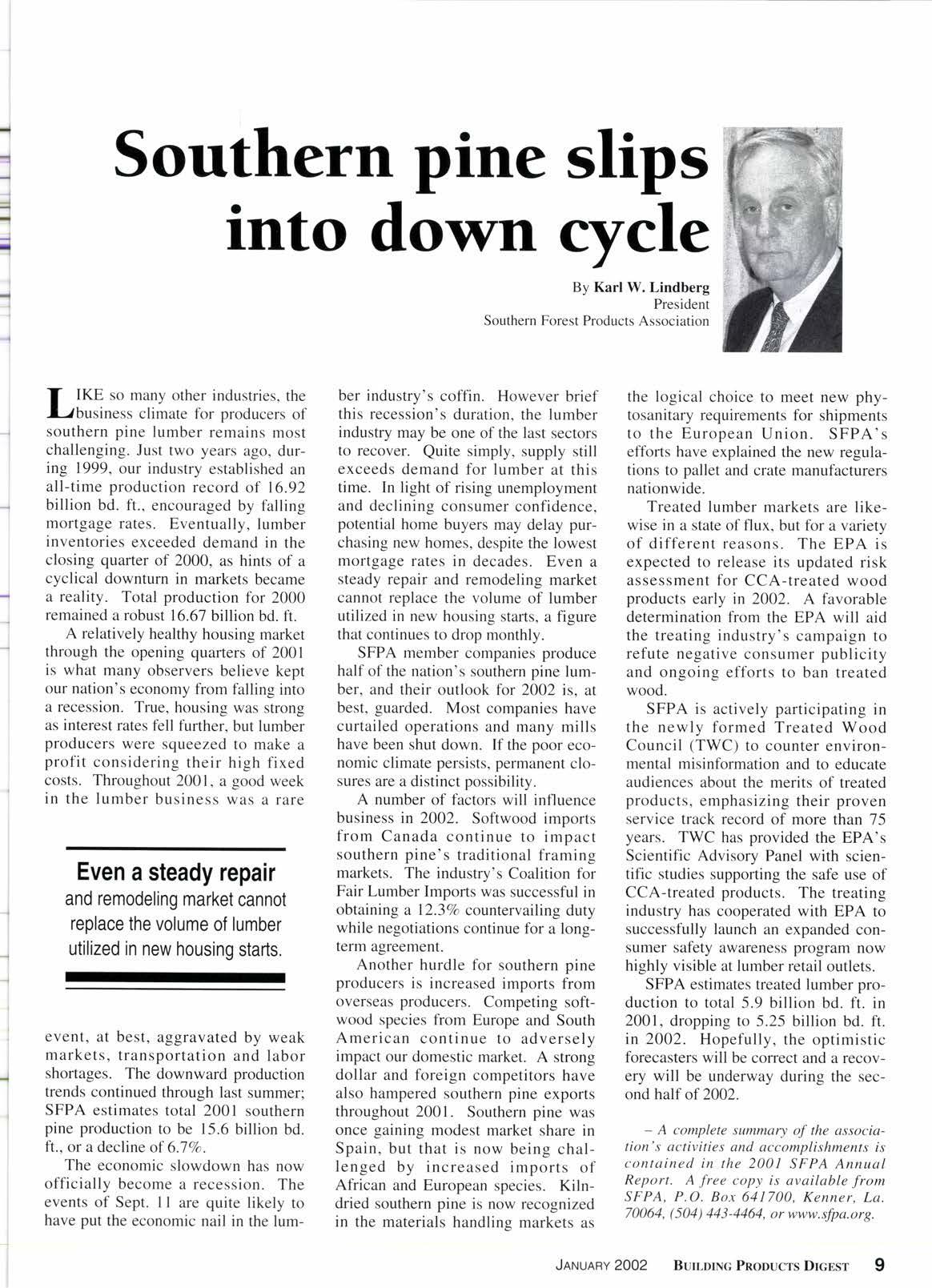
2 minute read
Southern pine slips into down cycle
By Karl W. Lindberg President Southern Forest Products Association
f IKE so many other industries. the l-Jbusiness climate for producers of southern pine lumber remains most challenging. Just two years ago, during 1999, our industry established an all-time production record of 16.92 billion bd. ft., encouraged by falling mortgage rates. Eventually, lumber inventories exceeded demand in the closing quarter of 2000, as hints of a cyclical downturn in markets became a reality. Total production for 2000 remained a robust 16.67 billion bd. ft.
A relatively healthy housing market through the opening quarters of 2001 is what many observers believe kept our nation's economy from falling into a recession. True. housing was strong as interest rates fell further, but lumber producers were squeezed to make a profit considering their high fixed costs. Throughout 2001, a good week in the lumber business was a rare ber industry's coffin. However brief this recession's duration, the lumber industry may be one of the last sectors to recover. Quite simply, supply still exceeds demand for lumber at this time. In light of rising unemployment and declining consumer confidence, potential home buyers may delay purchasing new homes, despite the lowest mortgage rates in decades. Even a steady repair and remodeling market cannot replace the volume of lumber utilized in new housing starts, a figure that continues to drop monthly. the logical choice to meet new phytosanitary requirements for shipments to the European Union. SFPA's efforts have explained the new regulations to pallet and crate manufacturers nationwide. best, aggravated by weak markets, transportation and labor shortages. The downward production trends continued through last summer; SFPA estimates total 2001 southern pine production to be 15.6 billion bd. ft., or a decline of 6.lVo.
SFPA member companies produce half of the nation's southern pine lumber, and their outlook for 2002 is, at best, guarded. Most companies have curtailed operations and many mills have been shut down. If the poor economic climate persists, permanent closures are a distinct possibility.
A number of factors will influence business in 2002. Softwood imports from Canada continue to impact southern pine's traditional framing markets. The industry's Coalition for Fair Lumber Imports was successful in obtaining a 12.3%o countervailing duty while negotiations continue for a longterm agreement.
Treated lumber markets are likewise in a state of flux, but for a variety of different reasons. The EPA is expected to release its updated risk assessment for CCA-treated wood products early in 2002. A favorable determination from the EPA will aid the treating industry's campaign to refute negative consumer publicity and ongoing efforts to ban treated wood.
The economic slowdown has now officially become a recession. The events of Sept. I I are quite likely to have put the economic nail in the lum-
Another hurdle for southern pine producers is increased imports from overseas producers. Competing softwood species from Europe and South American continue to adversely impact our domestic market. A strong dollar and foreign competitors have also hampered southern pine exports throughout 2001. Southern pine was once gaining modest market share in Spain, but that is now being challenged by increased imports of African and European species. Kilndried southern pine is now recognized in the materials handline markets as
SFPA is actively participating in the newly formed Treated Wood Council (TWC) to counter environmental misinformation and to educate audiences about the merits of treated products, emphasizing their proven service track record of more than 75 years. TWC has provided the EPA's Scientific Advisory Panel with scientific studies supporting the safe use of CCA-treated products. The treating industry has cooperated with EPA to successfully launch an expanded consumer safety awareness program now highly visible at lumber retail outlets.
SFPA estimates treated lumber production to total 5.9 billion bd. ft. in 2001, dropping to 5.25 billion bd. ft. in 2002. Hopefully, the optimistic forecasters will be correct and a recovery will be underway during the second half of 2002.
- A complete summary of the association's activities and accomplishments is contained in the 2001 SFPA Annual Report. A free copy is available from SFPA, P.O. Box 641700, Kenner. La. 70064, (504) 443-4464, or www.sfpa.org.










